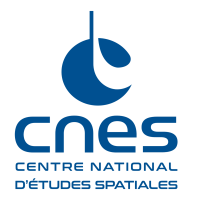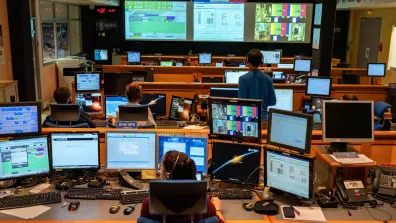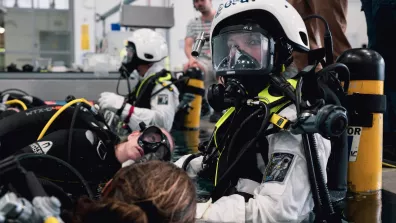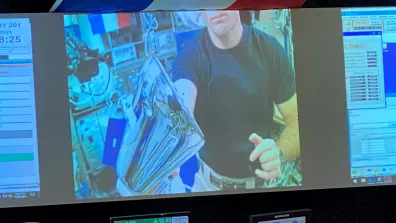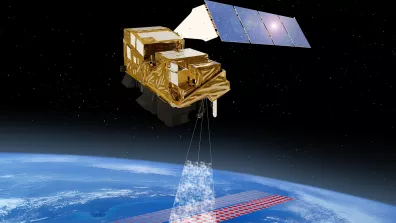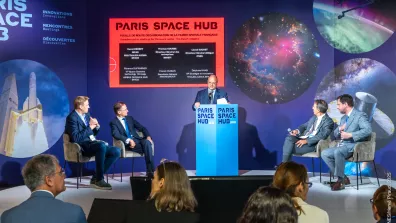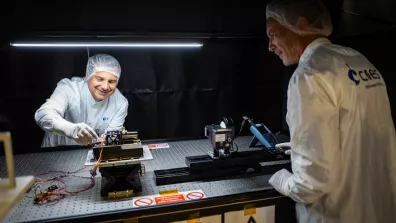What is the CADMOS centre and what does it do?
Rémi Canton: CADMOS is the centre for the development of microgravity applications and space operations, based at CNES’s Toulouse Space Centre. It was created in 1993 to structure human spaceflight activities that began with the flight of Jean-Loup Chrétien in 1982, when CNES still had its own astronaut corps. That’s where all French astronaut missions were monitored from, aboard the Mir space station and subsequently on the U.S. Space Shuttle and the International Space Station (ISS).
CADMOS in fact comprises two entities: one that develops experiments, working with research laboratories in line with CNES’s exploration roadmap, and one that’s in charge of operational monitoring of European experiments, in direct contact with the ISS crew.
- Project Manager for Human Spaceflight at CADMOS (CNES)
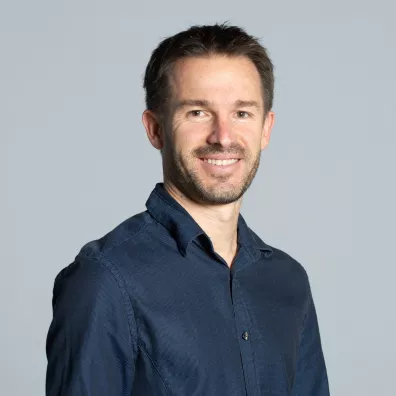
There are several ISS operations centres in Europe working on behalf of the European Space Agency (ESA), but CADMOS is the only one combining development and operations, spanning the entire value chain from expression of requirements to data collection. ISS operations and Europe’s contribution to the programme lend continuity to CADMOS’s role in developing experiments and monitoring operations, whether we have a French—or European—astronaut on the station or not.
How are experiments chosen for the ISS?
R. C.: There are two main criteria. The first is to support and accompany the French scientific community, with which we’ve forged close ties and which needs access to microgravity for its research. We therefore respond to this need by designing and preparing experiments for the ISS, working with the French and European industry base.
The second criterion is to pave the way for future crewed spaceflights and the technologies that need to be developed in this regard. To this end, CNES establishes a roadmap to set our priorities and we solicit laboratories and manufacturers to develop these technologies with us.
CNES is therefore free to choose experiments as it sees fit. They may be national or, more often, in partnership with another agency like ESA or NASA.
What types of experiment require microgravity conditions?
R. C.: Many physical, biological or physiological phenomena are masked on the ground by gravity. Aboard the ISS, Earth’s gravity is 90% of what it is on our planet’s surface, so by working in microgravity conditions we don’t free ourselves completely from gravity but rather from its effects, i.e., weight, thermal convection, buoyancy, sedimentation or hydrostatic pressure. This means we can observe phenomena that we’re not able to observe on Earth. There are two main families of experiments:
- Material sciences: the study of fluids, plasma, solidification and evaporation, etc.
- Life sciences: biology (plant and animal biology), exobiology, human physiology (cardiovascular system, neurosciences, organoids, etc.). Space medicine is very valuable because it highlights accelerated ageing, which fortunately is reversible.
Fundamental sciences (cold atoms, etc.) are more marginal.
How does CADMOS monitor space experiments, from preparation through to their return to Earth?
R. C.: We work closely with science teams to understand their requirements and then design experiment equipment and protocols with manufacturers. We’re familiar with the microgravity environment and its constraints, and with the process of qualifying and certifying equipment for the ISS, which is where we most add value. Alongside this, we establish operational procedures. Equipment delivered is then sent up to the ISS on resupply flights. In-orbit commissioning and then operations are monitored from our control centre at CADMOS, and the science data distributed to scientists for analysis.
Astronauts may be either subjects, for instance in the case of physiology experiments, or operators. Some experiments don’t require astronaut intervention and are controlled from the ground just like a satellite. Others are even installed outside the station, like ACES or Euro Material Ageing.
More specifically, how is CADMOS supporting Sophie Adenot?
R. C.: It’s important to note that CNES doesn’t only prepare experiments for French astronauts. The ISS is an international scientific research facility to which Europe, and therefore France, contributes to ensure continuous flight opportunities. French experiments are normally operated by ISS crew members, whatever their nationality. Our actual end-customer is science! But when a French ESA astronaut is on the crew, CNES puts together a suite of experiments to highlight their expertise while advancing our objectives and showcasing them on the station.
As previously for Thomas Pesquet’s Proxima and Alpha missions, we’re currently preparing a programme of science, technology and education experiments for Sophie Adenot’s mission, and working to help her take ownership of this national contribution so she can serve as its ambassador.
Are experiments conducted by CADMOS influenced by the directions that global space geopolitics is taking?
Geopolitics doesn’t really shape our scientific experiments, but it does have a strong bearing on how we work with other agencies.
When preparing for crewed space exploration, we adapt to the international context. For example, with the momentum imparted by the United States in recent years to return to the Moon, we’ve tapped into our expertise in areas applicable to lunar exploration to affirm our position and complement our partners. In particular, we’re contributing to life support activities with our know-how in health, nutrition, radiation, bio-contamination, waste processing and water recycling.
CADMOS also prepares experiments for Zero-G aircraft flights. How do these differ from space experiments?
Every year, CNES organizes two scientific parabolic flight campaigns, each consisting of three flights that perform 30 parabolas providing 22 seconds of weightless conditions. Just like on the ISS, experiments conducted on the Airbus A-310 operated by Novespace chiefly concern life and material sciences. Research laboratories submit proposals and we select ten experiments for each campaign, based on their feasibility and scientific merit. Sometimes we also fly our own experiments.
The main advantage for research scientists is that they can operate their own experiments and adjust settings and parameters between parabolas, rather than delegating the task to an astronaut.
Parabolic flights suffice for many experiments that don’t need to fly on the ISS because we’re talking about phenomena with a very short duration: for example, propagation of a flame front in a cloud of aerosols (which would also prove troublesome on the ISS for safety reasons!). Likewise, a parabolic flight isn’t necessarily a pre-requisite to sending an experiment into space. However, it can serve to “derisk” experiments for the ISS, by testing equipment or protocols, or making essential refinements before embarking on a longer sojourn.
Will France continue to send experiments into space after the ISS’s expected retirement from service in 2030?
Yes, because the scientific community still needs to conduct research in microgravity and low Earth orbit is the easiest place to do that. There are plans for private space capsules and stations, both crewed and robotic, with equipment in development in Europe and around the world. We’ll therefore be using these new facilities and continuing to support science and lay the groundwork for the technologies of the future.
In figures
-
8.6%
Share of European experiments on the ISS.
-
1 to 2
New French experiments installed per year on the ISS (outside French astronaut missions).
-
200
Experiments performed on average by an astronaut in six months aboard the ISS.
